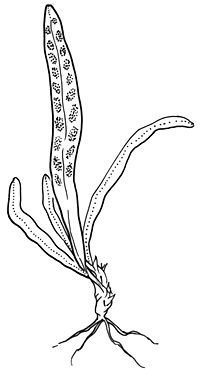Grammitis stenophylla Parris APNI* 
Description: Rhizome erect or short creeping.
Fronds mostly 1–6 cm long, 1–4(-6) mm wide wide; stipe indistinct, winged almost to the base, lacking hairs; lamina oblanceolate, apex obtuse to acute, glabrous, thin but leathery.
Sori subglobose to oblong, in the upper two-thirds of the frond, 2–25 pairs.
Distribution and occurrence: Grows on rocks in rainforest and in wet sclerophyll forest.
NSW subdivisions: NC, CC, SC
Other Australian states: Qld
Threatened species: NSW BCA: Endangered
Grammitis stenophylla and Notogrammitis billardierei can be difficult to distinguish. Four characters can help: 1) If there are no hairs on the stipe and base of the frond then the plant is probably G. stenophylla, if hairs are present on the stipe and base of the frond then the plant is N. billardierei; 2) If hydathodes are present at vein ends on the dorsal surface of the frond, then the plant is G. stenophylla, N. billardierei is not known to have hydathodes; 3) the sori in G. stenophylla are broadly elliptic, the sori in N. billardierei are narrower and may curve outwards; 4) the frond margins in G. stenophylla are more or less entire, whereas in N. billardierei they may be shallowly scalloped.
Text by Peter G. Wilson
Taxon concept: B.S. Parris (1998)
APNI* Provides a link to the Australian Plant Name Index (hosted by the Australian National Botanic Gardens) for comprehensive bibliographic data
***The AVH map option provides a detailed interactive Australia wide distribution map drawn from collections held by all major Australian herbaria participating in the Australian Virtual Herbarium project.
|


